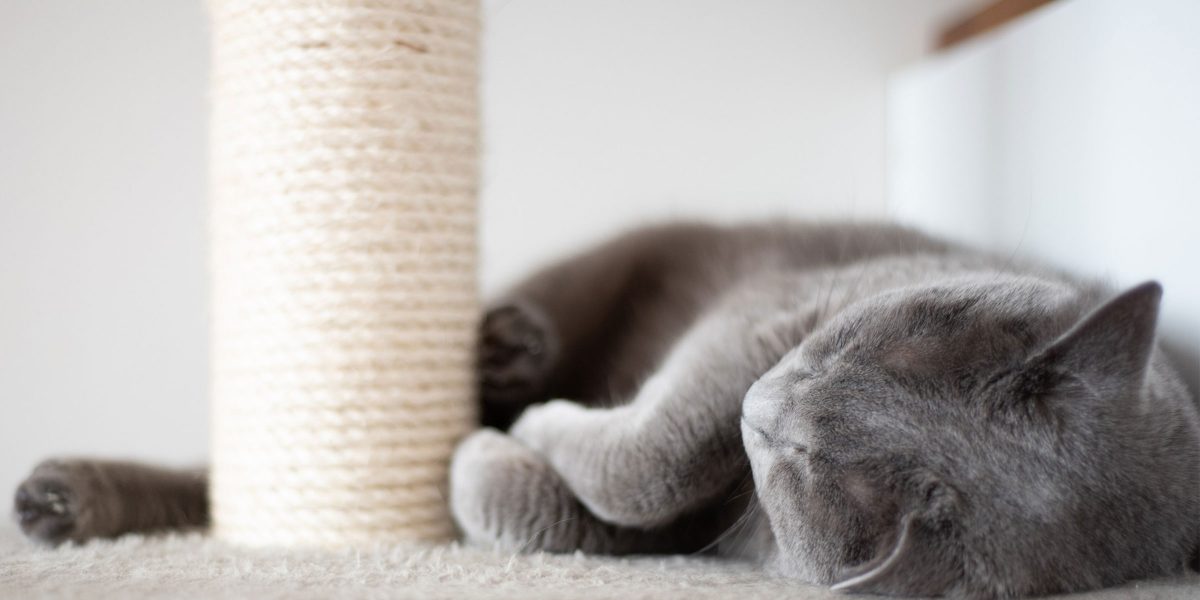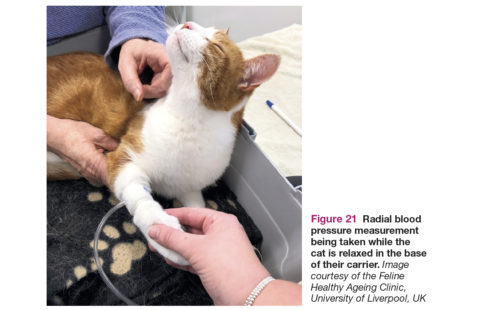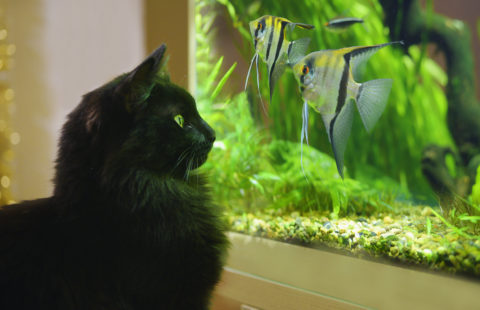What do we mean by scratching and why do cats do it?
If you’ve spent any time with cats you may have noticed that they may occasionally scratch on items with their front paws and claws. They do this by hooking their claws into the material and raking against the surface with their paws. Cats will scratch on both vertical and horizontal surfaces but often develop a preference for one or the other. Similarly, they can develop a preference for the type of material they like to scratch. Scratching behaviour is normal for cats and they perform this behaviour for a few different reasons.
One of the functions of scratching is to sharpen the tips of their claws and keep them in good condition. If you own a cat you may have noticed that the top coat of your cats’ claws, known as the sheath, can become worn and frayed. Scratching allows cats to remove this outer sheath which keeps the claws sharp and ready for use when climbing, hunting or in self-defence if needed.
Perhaps the most surprising reason for scratching, is its use in communication between cats. Cats deposit scents produced by specialised glands between their toes and on the main pad of their foot when they scratch. These scents can be detected by other cats and we believe that they use this as a way of marking out their territory. The visual marks left by scratching are thought to enable other cats to easily locate the scent mark, which provides them with information about the cat who originally left the scent. Whilst we may take more notice of cats scratching inside, cats also perform this behaviour outside and you may notice scratch marks on fence posts or other prominent areas within the garden. The exact purpose of scratching in this way is still unclear so we have more work to do to understand this behaviour fully.
Providing the best scratching facilities to meet your cat’s needs
If we understand why cats scratch, we can more clearly appreciate their need to express this normal behaviour. Instead of trying to prevent scratching behaviour, the focus should be on providing our cats with appropriate opportunities to perform this behaviour. We can do this by providing scratching facilities in the form of scratch posts, scratching mats or boards or more elaborate cat ‘trees’ that also incorporate platforms or enclosed sleeping areas.
However, are all scratching posts built equal? When looking at the options for cat scratching facilities there is often a huge array of choice in terms of the shape, size and material used. Different material options can include carboard, sisal rope, wood… it can be a minefield knowing where to start. Often the designs are catered to our human ideals, rather than focusing on what a cat really needs. This can lead to many scratch posts or boards being designed in a way that may in fact be off putting to a cat, rather than encouraging them, as we would imagine. This can lead to cats using other items, often inappropriate in our minds, such as the sofa or carpet. Therefore, it’s really important to consider which features make a great scratching facility for cats, as well as recognise the individual preferences of our own cats when providing the best resource for them.
Which features should we look for when buying a scratch post or board?
Horizontal or vertical scratching facility?
- Watch your cat and see if they show a preference for scratching vertically or horizontally. For example, do they particularly target their scratching on horizontal surfaces such as carpets or the bottom step of the stairs? Or on vertical surfaces such as the arm of the sofa or table leg?
- If they don’t show a preference for either it would be good to provide options for both types of scratching.
- If you have more than one cat in the home, you need to provide for the preferences of all the cats.
Height
- The post or board needs to be tall enough that the cat can fully stretch out and extend their legs whilst scratching.
- A minimum height of 60cm is advised for an adult cat.
- Remember that if you have a kitten, they will quickly grow into an adult cat and ‘kitten sized’ scratch posts will no longer be appropriate. It is always best to think ahead when buying items for your cat.
- Some cat trees include scratching posts, which provide sleeping and scratching facilities in one place. However, sometimes the interruption of a platform for resting or sleeping can mean the post is not tall enough as in the photo below.
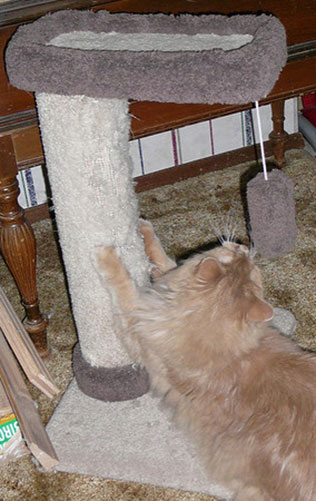
An example of a cat tree where the supporting post is also a scratching post (Source: Flickr.com)
Stability
- One of the most off-putting features for a cat is a scratch post that moves, wobbles or bends when they place their weight against it. Posts become ineffective for use and can even give a cat a fright if they move unexpectedly, putting a cat off from using it again.
- The scratch post therefore, needs to have a wide, heavy base to help support your cats’ weight when they scratch. If the post begins to wobble and can’t be mended don’t be tempted to leave it, it’s time to buy a new one.
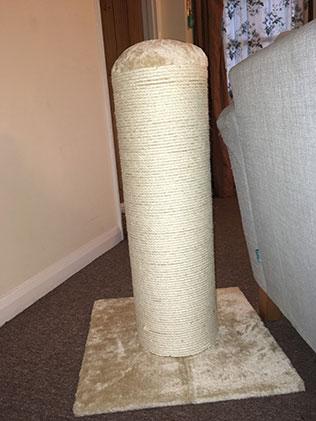
Example of a scratching post that is tall, wide and sturdy (due to the large base) (©Lizzie Rowe)
The material
- Materials that provide resistance when scratching include sisal twine, corrugated cardboard, carpet or bark/wood.
- Loop weave carpet and heavy-duty carpet designed for high traffic areas are recommended when providing carpet scratching facilities which are good for horizontal scratching.
- Some owners may worry that providing a scratching board or post made with carpet will encourage cats to scratch carpet around the house. However, there is no evidence for this, and if attractive scratching facilities are provided then a cat will target these and not furniture or items around the house.
- Materials with a vertical weave are considered to be better than horizontal weave as it allows cats to drag their claws downwards. Nonetheless, many cats do appear happy with using scratching boards and posts with sisal twine wrapped horizontally.
- Age may influence a cat’s preference for a material. A study of cat owners found that older cats between the ages of 10 and 14 years showed a preference for carpet substrate most frequently, while all other ages preferred scratching facilities made of rope first.
iCatCare behaviour expert Dr Sarah Ellis provides us with her thoughts as to why this might be “Older cats may not have as much muscular power in their limbs for scratching. The resistance provided by the tight structure of the sisal is likely to be much greater than that of carpet and therefore would require greater strength to pull the claws through. Carpet is therefore likely to be an easier and more comfortable option for older cats.”
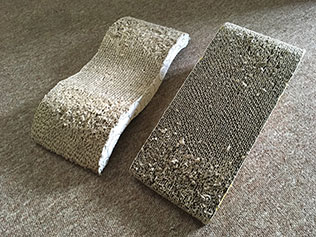
Examples of angled boards made from corrugated cardboard (©Lizzie Rowe)

Example of a sisal rope scratching board attached to a vertical surface – in this example it is hanging off a door handle (Source: practicallyfunctional.com)
How many scratching facilities should there be?
- It is common practice to just buy one scratching post for a cat. However, as cats can perform this behaviour frequently throughout the day (and night), having multiple options increases the likelihood that a post or board will be used over other items such as furniture.
- The number of scratching facilities to provide in your home very much depends on the number of cats in your home and the size of your home. If you have multiple cats living in a home then avoiding the need for cats to share facilities helps prevent competition for resources occurring.
- The usual rule of thumb for the number of key resources is to provide one per cat plus one extra. For example, in houses with two cats, three scratching posts should be provided as a minimum. Seems a lot? Compared to the damage caused by a cat scratching carpets and furniture, placing three scratching posts around the home may be less of a deal.
Where should they be located?
- The location is another really important factor to consider when encouraging the use of scratching facilities provided. We often place scratch posts in visually pleasing locations for us, usually out of the way or in corners of the room. Unfortunately, this doesn’t always match up with what our cats need.
- Cats often scratch after waking up, so scratching facilities should be provided near sleeping areas. Scratch posts, or boards attached to the wall, are best in these locations as cats usually stretch up when scratching after waking.
- As cats scratch during territorial marking, having scratching facilities at the boundaries of their territory, for example, near entrances and exits to the home, can help prevent inappropriate scratching here.
- If your cat has already started using the furniture or other undesirable locations then scratching facilities should also be placed near or in front of these areas. This will encourage the cat to use the scratching resource and not the inappropriate object. If this is not a suitable location for the post or board to remain permanently, then the scratching facility can be moved very gradually (i.e., a couple of centimetres at a time) to a more desirable location.
- It is also really important not to punish cats for scratching, including shouting at them – this may cause anxiety for the cat and potentially lead to other problems such as the cat actively avoiding you.
Don’t forget to encourage the use of them!
- It was common advice to physically place a cat’s paws on the scratching post and encourage them to scratch by moving their paws up and down. However, this sort of handling can be frightening and intimidating for cats and there are kinder and more effective ways to encourage the use of a scratching facility.
- Placing dried catnip or spraying catnip scent onto the scratching post or board may encourage a cat to approach and investigate it.
- Gentle praise can help encourage a cat to repeat the behaviour if you reward them immediately after they scratch in the correct place.
- Playing a game using a piece of string or fishing-rod style toy around and over the post or board will encourage the cat’s claws to make contact with the surface. This in turn often encourages the cat to return to the resource and use it to scratch.
- Move the location! If the cat isn’t using a scratch post or board, try moving it to another area of the house. The novelty may encourage the cat to re-investigate it.
- Another way to potentially encourage the use of a scratching resource is by using a product called ‘Feliscratch’. This is a synthetic version of a pheromone, which is released by scent glands on the main pads of the cat’s feet during scratching. Pheromones are chemical messages used by cats to communicate with one another. This pheromone is also believed to encourage the cat to return to a place they have previously scratched. By applying this synthetic version of the pheromone to scratch posts or boards, we can help attract a cat to scratch in a location of our choosing. (To find out more about this product please visit the manufacturers website here).
- Place a food treat on the top of the scratching post – this can encourage interaction with the scratcher that can lead to scratching behaviour.



